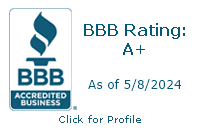Interested in some books that let you easily pick and choose topics of interest to you?
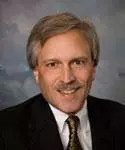
This June marks the twenty-first time I've suggested several books for summer reading. As in prior book reviews, I'm always concerned about my limited time available to skim or read sections of the books, so I tend to go straight to sections most relevant to what I need at that moment. This year, I am taking this one step further by recommending books where YOU can easily pick and choose the content that most interests you, because my goal is to help YOU make the best use of YOUR limited time.
Reset: How to Change What's Not Working, by Dan Heath (2025)
Todd's Question – “What steps can I take to help my team fix problems?”
I like books from Dan Heath, whether written by himself or with his brother Chip Heath – they're well-written and well-organized to allow business readers to find and extract value quickly.
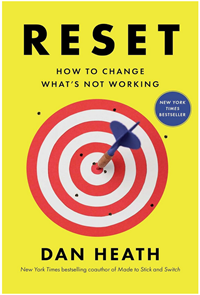
If you need to reset a process – that is, change a process that's not working – follow the two-part guidance outlined in the book. The 16-page Introduction takes you through a quick case study of how this guidance was applied to solve a significant real-world problem, previewing each step in the Reset process.
Here's the two-part Reset process, along with my summary of each step:
- Section 1: Find Leverage Points – A leverage point is a breakdown or a constraint that prevents a process from working as desired. Here are the chapters to help you find these:
- Section 2: Restack Resources – Your process is already consuming resources – time, money, enthusiasm, computing power, and the like – yet not producing the results you'd like. The idea is to “align all of those assets so that they push in the same direction.” You can improve your alignment using the following chapters:
Bottom Line – This book's content provided numerous examples and explanations I can use when working with clients. Over the 35 years of Todd Herman Associates (THA), I've developed my particular way of explaining things to my clients. Most of the time, this works – when it doesn't, it's always good to have different ways to explain problems and how we help solve them.
Clear Thinking: Turning Ordinary Moments into Extraordinary Results, by Shane Parrish (2023)
Todd's Question – “How can I more consistently think more clearly?”
The author's premise is in the book's Preface – “There's no class called Clear Thinking 101 in school.” I've seen the truth of his statement many times in my life – some people can quickly and correctly size up a particular problem and envision its solution, while others can't.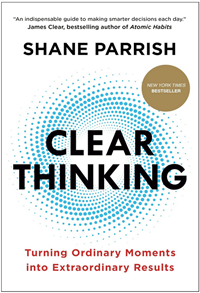
While some problems require domain-specific knowledge, many don't – and for both types of problems, the author recommends taking the following steps:
- Creating Space for Clear Thinking – Here are the Parts (chapters) that help you create space:
- Putting Clear Thinking Into Practice – To do this, refer to these Parts for guidance:
Bottom Line – I found the ideas in Chapter 4.4, “Do It!,” to be worth the price of the book! The examples and the 2x2 matrix of the Reversible vs Consequential Model helped me better see how much time to spend deciding what to do and when I should make a decision. For less consequential and more reversible decisions, such as moving small furniture, decide ASAP – As Soon As Possible – because there's little downside and you can quickly change course. For more consequential and less reversible decisions, such as buying a “fixer upper” house, decide ALAP – As Late As Possible – because there is generally a large amount of money or risk involved, and it would take a long time to recover from a poor decision.
Same as Ever: A Guide to What Never Changes, by Morgan Housel (2023)
Todd's Question – “What things can I always hang my hat on?”
The author explains the book's premise in the Introduction: The Little Laws of Life – he shares 23 short stories (each 4 to 13 pages) about what he calls “The Laws of Life.”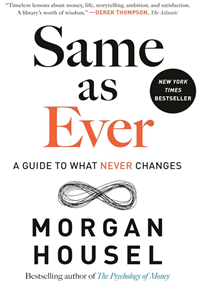 Using the annotated Table of Contents, I found two stories that stood out to me:
Using the annotated Table of Contents, I found two stories that stood out to me:
- Wild Numbers: People don't want accuracy. They want certainty. – The author uses a number of examples – frequency of miracles, odds of winning the lottery twice, the stock market, and his experience as a college student parking cars – to illustrate that the probability of something occurring can be accurately estimated, yet people still want certainty in their particular situation. That's why folks will turn to “authoritative-sounding people” – that is, experts – without recognizing even experts can be wrong. (What I've observed is that people who want certainty are good prey for con men, since they speak in certainties, not probabilities!)
- Trying Too Hard: There are no points awarded for difficulty. – The premise here is that complexity is interesting and attractive, while simplicity is boring and ordinary. Cancer research is complex – cancer prevention is simpler. Constructing new roads grabs attention – repairing existing roads mostly goes unnoticed. There's also this gem – “A trick to learning a complicated topic is realizing how many complex details are cousins of something simple.” So true! For instance, Accounting involves a LOT of specific rules, yet they are all derived from basic principles, such as Revenue Recognition, Matching Expenses with Revenues, Materiality, Financial Statements, and the Accounting Equation. Once you understand these basic principles, you can more easily understand the rationale of, say, new accounting pronouncements.
Bottom Line – This book provides numerous examples to help explain and illustrate each of the author’s 23 “Laws of Life.” While only a story or two might apply to you at any one time, the longer-term insights they provide will help you live and make decisions based on things that never change.
Who Is Government? The Untold Story of Public Service, edited by Michael Lewis (2025)
Todd's Question – “What are the stories behind governmental services we rely upon, yet may take for granted?”
If the name Michael Lewis seems familiar, it's because he's written several best-selling books, including Moneyball and The Big Short, both made into popular movies.
I learned of this book during the book's rollout in early April 2025, when I heard Michael Lewis (the book's editor and author of two stories in the book) on a podcast one day and on a news program the following evening.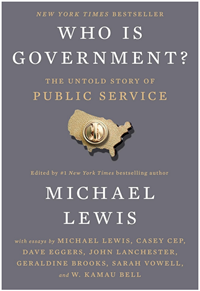
The book's title grabbed me because it made me realize that the US government is NOT a “What” – rather, government is a collection of “Who.” While our elected federal officials get the most (truthfully, too much) press and airtime, this book focuses on the nameless people whose job is to do the work asked of them. These people – actually, these employees of the American people – are often referred to as “bureaucrats.”
The word “bureaucrat” has a negative connotation because elected officials often hurl it as an insult to justify slashing the size of government. Admittedly, it is easy to want to slash positions the public believes provide no benefits to We The People.
Who Is Government? contains eight vignettes telling the story of either federal civil servants or of a key number – the Consumer Price Index (CPI) – produced by our national government, and describe how people and businesses benefit from these efforts
The story of Christopher Mark in “The Canary” kicks off this book. Here's a description of this man that captivated the author, Michael Lewis:
Christopher Mark: Led the development of industry-wide standards and practices to prevent roof falls in underground mines, leading to the first year (2016) of no roof fall fatalities in the United States. A former coal miner.
The rest of the section tells the amazing story of the life and work of this former coal miner, whose father taught at Princeton.
John Lanchester, author of the story, “The Number,” opens with 2.5 pages describing only a small fraction of the statistics created and compiled by our federal civil servants. The most famous of these statistics is the Consumer Price Index (CPI), which is used, among other ways, to set levels of Social Security payments and various tax brackets. The CPI is used to adjust salaries, business contracts, and even divorce settlements to reflect inflation. As this author sagely notes, until Covid-19, we forgot what significant inflation feels like. The pandemic reminded us about rising prices and the importance of the metric used to track them, the CPI.
Bottom Line – Our neighbors, folks in the grocery store, people we see at church – we know, like, and trust them without realizing many are employed by our government. This engaging book tells you about the work done by some amazing federal civil servants, putting flesh and blood on services we generally take for granted – until they're taken away from us.
Picking and Choosing
Regardless of your objective – to improve your business, think more clearly, understand some “Laws of Life” that never change, or be fascinated by how one person's idea created a valuable public service – these well-written books are packaged so you can pick and choose what's most interesting and useful to you.
Sincerely,
![]()
Todd L. Herman
PS – Please check out our most recent video – Grow Employees' Careers, Grow Your Business



